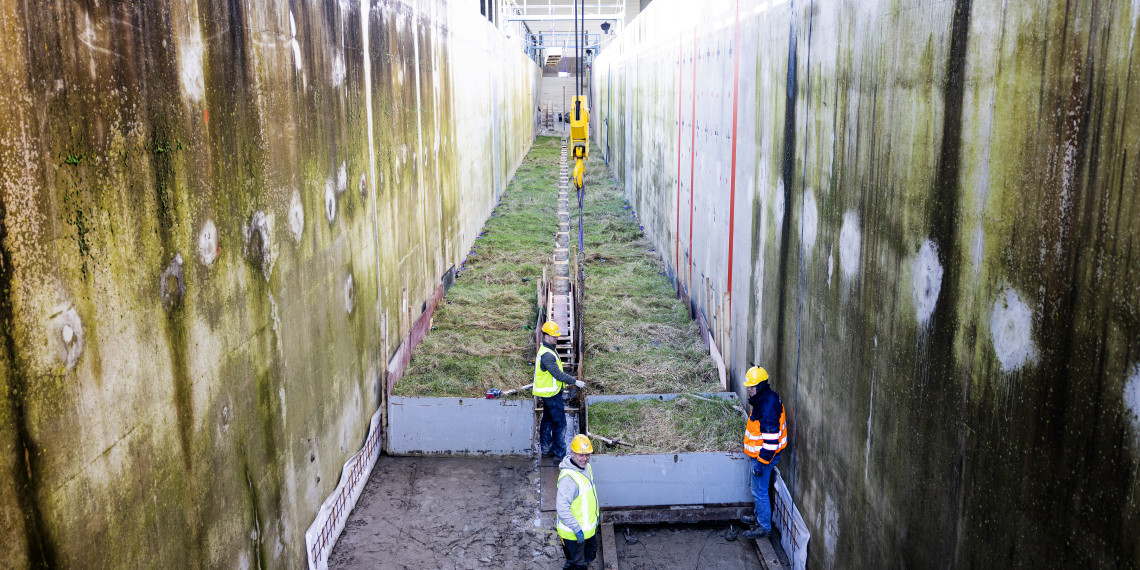Two million euros of investments, four years of preparations, and three hundred square meters of soil and vegetation transported half across the country. All for one experiment. For the first time in history, scientists were able to rebuild a living dike on a 1:1 scale – to test if this solution can help ‘keep our feet dry’ in spite of the changing climate.
Held in the Delta Flume on the outskirts of Delft, the unique experiment began on the 19th of February and will run until mid-March 2024. ‘It is THE test we need to do, and not just from an academic perspective,’ says Bas Borsje, Associate Professor of Nature-based Flood Protection at the University of Twente. ‘If we are successful, we can really serve the coastal community and prevent floodings. It is a very important step in developing climate adaptable solutions.’
Delta Flume
Delta Flume (in Dutch: de Deltagoot) is a test facility located at the Deltares Research Institute just outside Delft in the Netherlands. Its wave generator is capable of producing waves up to 4.5 metres high, making these the largest artificial waves in the world. The facility is used for full-scale tests of the effect of extreme waves on dikes, dunes, breakwaters and offshore structures, helping find innovative flood defense solutions.
The flume is 300 metres long, 9.5 metres deep and 5 metres wide. This length is needed to simulate wave formation on gradually rising coasts. A water reservoir containing 9 million litres of fresh water is located alongside the Delta Flume. That is the equivalent of four Olympic swimming pools.
Source: Deltares.
Natural solution
Bas Borsje is an expert in the field of coastal protection and flooding - an ‘urgent topic’, as he says himself. In 2022, nearly 55 million people worldwide were impacted by flooding. With his research, Borsje therefore aims to find solutions to protect us against rising sea levels. Instead of relying on traditional engineering solutions, such as dikes made of asphalt, he searches for solutions inspired by nature. Because unlike existing man-made dikes, which are static and need regular maintenance, natural solutions can evolve and grow together with the sea.
‘Given the rising sea level and the changing climate, we can’t keep relying only on traditional solutions. It should not be a fight against the sea, it should be about embracing nature – because that solution is a lot more sustainable,’ says the UT researcher.
The main solution that Borsje is investigating – and currently testing in the Delta Flume – is so called ‘living dikes’, grass dikes with wetlands in front of them. As he explains, these living dikes have many advantages compared to traditional solutions. They buffer the coast against storms by reducing wave‐loading and they are climate adaptive as they capture sediments and grow with the rising sea level. This means they will be there for years to come, able to protect the coast – and us – from flooding.

The living dike (at 1:1 scale) in the Delta Flume.
Realistic test
‘The experiment in the Delta Flume will put the crown on all the work we’ve done,’ says Borsje. Because, until now, all tests with living dikes had to be scaled down. ‘But when you scale down, you have to make assumptions about your findings,’ adds the scientist. ‘In Delft, we can test everything at the right scale for the first time.’
The scale is particularly important because vegetation is a crucial component of this experiment – and of living dikes. To make the tests as realistic as possible, the scientists used 66 blocks of soil and vegetation directly from salt marshes in Friesland. After being transported across the Netherlands, the vegetation blocks are now placed on the bottom of the Delta Flume, forming about seventy meters of salt marshes. ‘This is necessary because we need an adequate length to measure the vegetation’s effect on wave damping,’ clarifies Borsje.
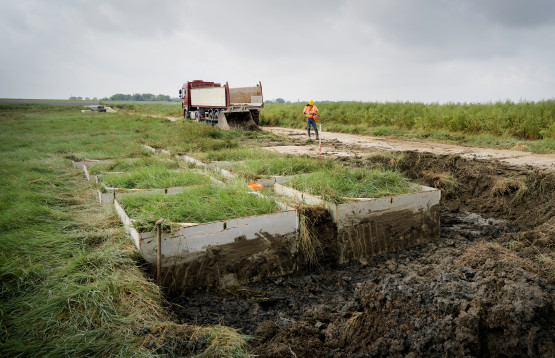
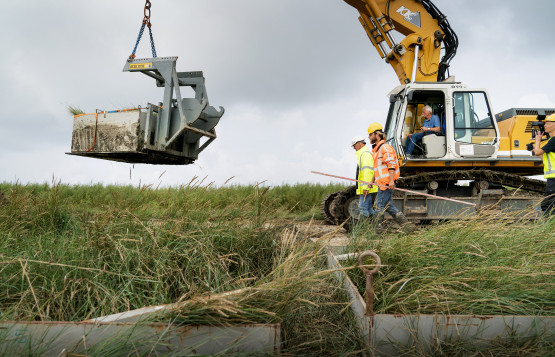
Blocks of soil and vegetation being removed directly from salt marshes in Friesland and transported to Delta Flume in September 2023.
Waves as high as trees
Every day for a month, the researchers run tests using different settings, different water levels and various types and heights of waves. They will start ‘easy’, using low waves, but gradually increase the intensity, explains Borsje. ‘We will be able to test extreme scenarios up to the level of a severe storm, the type of storm that comes once in ten thousand years. We are talking about waves as high as trees.’
The goal: to test at what point the dike collapses. In other words, to determine if salt marches can protect us from flooding – and to what degree. ‘This is the first experiment of its kind,’ says Borsje. ‘However, a similar test at a smaller level was held in Hannover and showed that vegetation can have a big impact on wave damping, and that we need research at a 1:1 scale to determine how big this effect really is.’
As the UT scientist explains, it is assumed that vegetation has a huge impact on wave damping and that it helps to prevent erosion. ‘We expect that the experiment in Delft will prove that salt marshes have a significant effect in terms of flood protection, but only as long as the vegetation is there. What we don’t know is what happens when the vegetation is broken down by severe waves. It’s necessary to find out, because more than one storm can hit in one season – and if the first storm damages the vegetation, it might not be capable of protecting the coast when the second storm hits.’
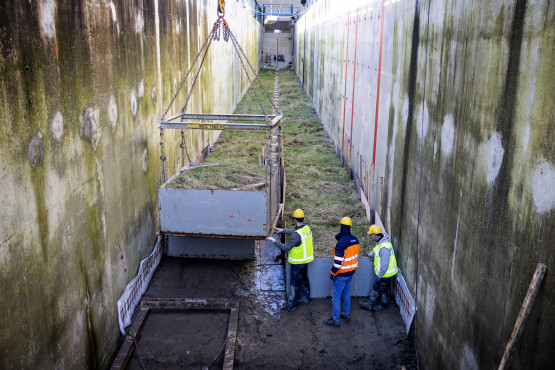
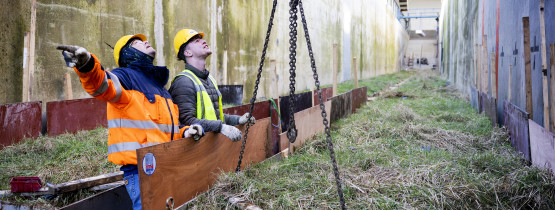
The vegetation blocks being placed on the bottom of the Delta Flume in preparation for the ongoing experiment.
The future of dikes
The ongoing experiment can therefore have major implications for the future of dikes. ‘This is a huge step for us,’ says Bas Borsje. ‘The experiment costs more than two million euros and is paid by Het Hoogwaterbeschermingsprogramma (HWBP), an organization focused on reinforcing all dikes in the Netherlands. You might think this is a lot of money, but as soon as we can prove that living dikes can effectively dampen waves and prevent flooding, we can prevent the need to reinforce dikes in other ways. The money for this experiment easily outweighs the investments that would be needed for strengthening dikes.’
And stronger – or different types of – dikes will be needed, adds the UT expert. ‘The changing climate will only increase the likelihood of extreme rainfall, heavy storms and a rise in sea level. We can continue to raise the height of the current dikes, or we can search for more sustainable solutions.’
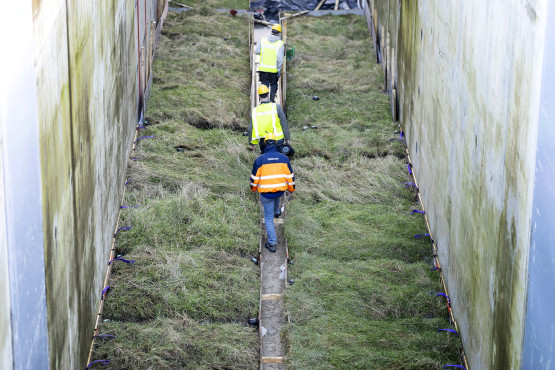
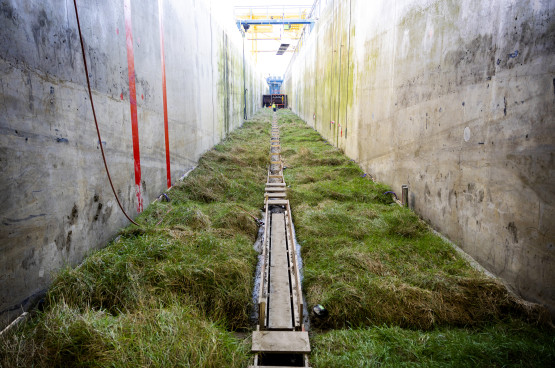
The bottom of the Delta Flume covered in soil and vegetation directly from salt marshes in the Netherlands. A small path in between the blocks is necessary because researchers will need to access the blocks on a daily basis. Every day, the flume is emptied so that the scientists can do measurements and evaluate the erosion and the state of the vegetation.
Worldwide
The findings could be very valuable not only for the Netherlands. ‘Living dikes can be anywhere where salt marshes are, which is almost everywhere around the world,’ says the UT expert. ‘Vegetation can grow essentially in all coastal areas, although in tropical regions it mostly has the form of mangroves, rather than salt marshes. Regardless, living dikes could help a lot more countries than only the Netherlands. They could help protect many areas all around the globe.’
Even though the exact results of the Delta Flume tests will not be available for a few months, Borsje is positive about the outcomes. ‘If we are successful, the next step is to construct our own living dikes. We are now doing the test with fully grown salt marshes, but it would of course be valuable to have salt marshes that don’t take decades to grow. Right now, salt marshes are not taken into consideration when assessing the safety of coastal areas. This work could change that. Ultimately, I want to see living dikes in real life. That is the goal of my research and this experiment.’
UT team
The ‘living dike’ experiment is led by a team from the University of Twente. Alongside Bas Borsje, an Associate Professor of Nature-based Flood Protection at the Marine and Fluvial Systems chair, the team includes Professor Suzanne Hulscher, postdoc researchers Pim Willemsen and Thomas van Veelen, PhD candidate Jos Muller and technician Emre Ozturk, all from the UT Faculty of Engineering Technology.


